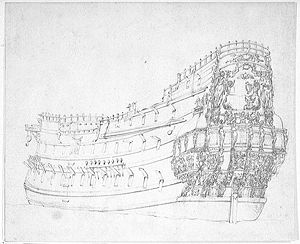HMS Victory (1666)

Portrait of Victory by Willem van de Velde the Younger, 1655
|
|
| History | |
|---|---|
|
|
|
| Name: | Victory |
| Builder: | Andrew Burrell, Deptford |
| Launched: | 1620 |
| Fate: | Broken up, 1691 |
| Notes: | |
| General characteristics as built | |
| Class and type: | 42-gun great ship |
| Tons burthen: | 870 bm |
| Length: | 108 ft (33 m) (keel) |
| Beam: | 35 ft 9 in (10.90 m) , later raised (probably through girdling) to 37 ft 6 in (11.43 m) |
| Depth of hold: | 17 ft (5.2 m) |
| Sail plan: | Full-rigged ship |
| Armament: | 42 guns of various weights of shot |
| General characteristics after 1666 rebuild | |
| Class and type: | 82-gun second-rate ship of the line |
| Tons burthen: | 1029 74/94 tons |
| Length: | 121 ft (37 m) (keel) |
| Beam: | 40 ft (12 m) |
| Depth of hold: | 17 ft 6 in (5.33 m) |
| Sail plan: | Full-rigged ship |
| Armament: | 82 guns of various weights of shot |
Victory was a 42-gun great ship of the English Royal Navy, built by Andrew Burrell at Deptford and launched in 1620. She was first commissioned in 1627 under Captain Thomas Kettleby for the abortive attack on La Rochelle. During the First Anglo-Dutch War, under the command of Lionel Lane, she took part in the Battles of Dover (19 May 1652), Dungeness (29 November 1652), Portland (18 February), the Gabbard (2 June 1653 – 3 June 1653) and Texel (31 July 1653). By 1660 she was armed with 56 guns.
By 1665, Victory had been reduced to ordinary status at Chatham Dockyard, and in 1666 she was rebuilt there by Phineas Pett II as an 82-gun second-rate ship of the line. Recommissioned under Sir Christopher Myngs, she took part in the Four Days Battle of 1666 (where Myngs was killed), and on 25 July 1666 in the St James's Day fight under Sir Edward Spragge. During the Third Dutch War she participated in the Battle of Solebay (on 28 May 1672 under Lord Ossory), the two Battles of Schooneveld (on 28 May and 4 June 1673 under Sir William Jennens), and the Battle of Texel (on 11 August 1673, still under Jennens). By 1685 her armament had been reduced to 80 guns.
...
Wikipedia
